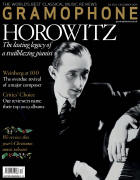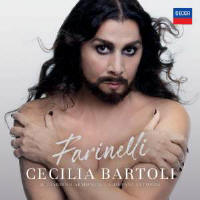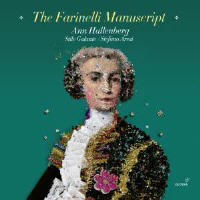Texte paru dans: / Appeared in:
|
|||||||
|
Outil de traduction (Très approximatif) |
|||||||
|
Reviewer: Richard Wigmore What would one give to time travel and hear the 18th century’s most deified, mythified castrato, who in London provoked the accolade ‘One God, one Farinelli’? The composer Joachim Quantz left a famous description of a singer who dazzled audiences not only with his virtuosity and freakish three-octave range but with his flawless ‘taste’ and expressive subtlety: ‘A penetrating, full, rich, bright and well modulated soprano voice … his intonation was pure, his trill beautiful, his breath control extraordinary and his throat very agile … Passagework and all kinds of melismas were of no difficulty to him.’ An impossible act to follow, of course. But it’s hard to think of two contemporary singers who could revive Farinelli’s repertoire with the skill and flair of Cecilia Bartoli and Ann Hallenberg. Predictably, Bartoli is the more combustible of the two star mezzos, singing arias by Farinelli’s mentor Nicola Porpora and his brother Riccardo Broschi with her trademark devil-may-care élan. She sets out her stall in the joyous ‘Nell’attendere il mio bene’ by Porpora, Handel’s rival in London in the 1730s. With singing of such febrile energy, sound and verbal sense in perfect marriage, you can easily forgive the odd squally moment above the stave. Bartoli unfurls her perfectly controlled messa di voce in an alluringly phrased aria for Hymen from Porpora’s La festa d’Imeneo, composed to celebrate the wedding of Frederick Prince of Wales – though you wouldn’t glean this from the booklet. Happily there is little here of that cooey, breathy tone which can quickly pall. In ‘Alto Giove’, now a popular aria with countertenors, Bartoli touchingly, and specifically, catches the dazed wonder of Acis as he is transformed into a fountain. Seconded by the percussive, hyperactive strings of Il Giardino Armonico, she is ferociously in her element in a ‘rage’ aria from Hasse’s Marc’Antonio e Cleopatra and conveys an underlying restless anxiety in the ostensibly happy ‘Lusingato dalla speme’ from Polifemo. Bartoli also vindicates a pair of less distinguished arias by Farinelli’s brother Riccardo Broschi, etching sorrow into the texture of her voice in ‘Chi non sente al mio dolore’ and pulling out all the bravura stops in the vengeful trumpeting of ‘Sì, traditor tu sei’. Here and elsewhere she mines the expressive and dramatic potential of the Italian language with Cecilia Bartoli sings with combustible virtuosity unique intensity. Her terrifying cry of ‘barbaro’ will have you cowering. While this is as at least as fine vocally as Bartoli’s recent Vivaldi album (2/19), Decca’s visually lavish presentation lives down to the same dubious standards. I suppose some might be amused/intrigued by the endless photos of a bearded Bartoli looking for all the world like a feminised Russell Brand. There are good essays, including one by Alexandra Coghlan, on the Farinelli phenomenon. But – here I go again – nowhere is there a word on the context of these arias, crucial to a full appreciation of the music. If you’re wondering who on earth is Eptide in Broschi’s La Merope or Nino in Porpora’s Semiramide, I’m with you. Will someone at Decca ever get the point? Depressingly, Glossa’s otherwise scholarly booklet notes likewise breathe not a word about the context of the six (mainly) rare arias on Ann Hallenberg’s album ‘The Farinelli Manuscript’. In semi-retirement in Madrid, the castrato assembled these arias, many of which he sang to allay King Philip V’s depression, as a gift to Empress Maria Theresa. On the cusp of the Baroque and the galant, they tend to be thinner musically than the arias on the Bartoli album. With its reams of inanely insistent triplets and sudden rocketing high notes, the anonymous ‘Al dolor che vo’ sfogando’ that ends the disc emerges as little more than a series of vocal exercises. Still, Hallenberg, her mellow yet incisive tone perfectly ‘centred’, has you gasping in admiration at her mingled virtuosity and expressive power. While her coloratura is less frenziedly driven than Bartoli’s (which some may deem an advantage), she rivals the Italian in go-for-it bravado. In Broschi’s rip-roaring tempest-at-sea aria ‘Son qual nave’ (the one relatively familiar item here), Hallenberg strides fearlessly across the two-and-a-half octave compass, unerring in her negotiation of improbable leaps and plunges, and deploying a sonorous baritonal extension in the slow central section. Beyond the virtuoso fireworks, Farinelli was famed for the subtle inwardness of his singing. Hallenberg can be aptly dulcet too, whether in a flirtatious minuet aria by Farinelli’s one-time colleague Niccolò Conforto, sung with a smile in the tone, or the tender pathos of Gaetano Latilla’s ‘Vuoi per sempre abbandonarmi?’ (we deduce merely that this is a woman jilted by her faithless lover). With the breath control of an underwater swimmer, she takes in her stride the extravagances of Farinelli’s added ornaments and cadenzas (‘Wow’ was my scribbled reaction, more than once); and crucially for a singer of this repertoire she musters a true trill. All the while Stefano Aresi’s Stile Galante, using single strings, are vivid accompanists. Playing with the bell held upwards, trilling horns create a spectacular racket in an otherwise bland aria by the obscure Giovanni Mele. Reservations linger about the musical quality of these prolix display arias. But if anyone today – other than Bartoli – has the technique and imagination to make them live, it’s Ann Hallenberg |
|||||||





